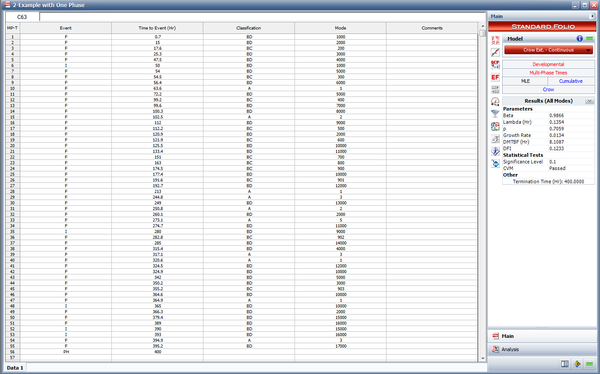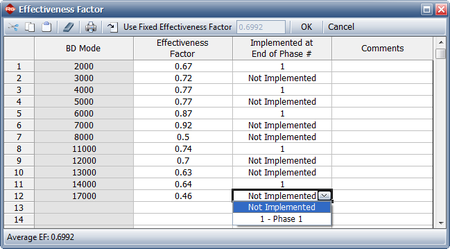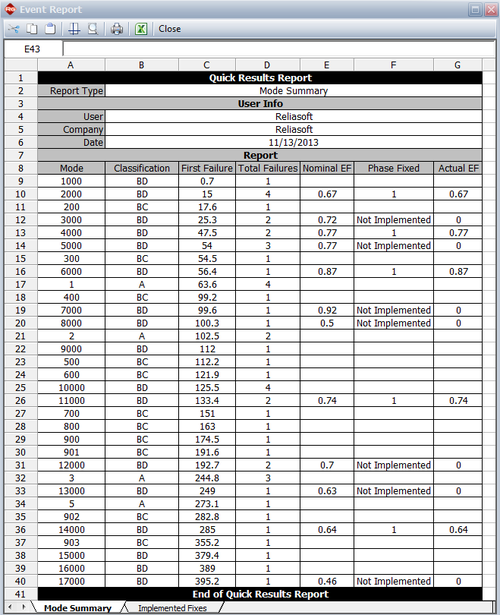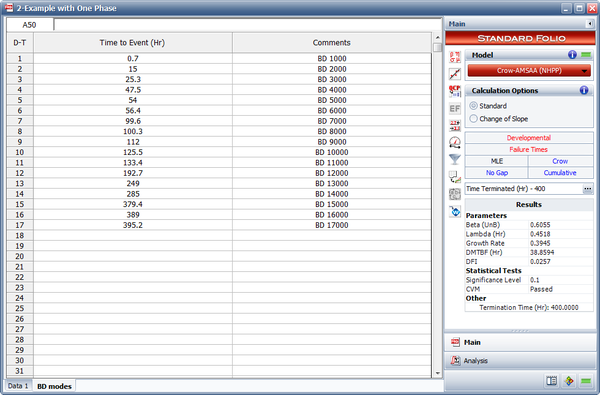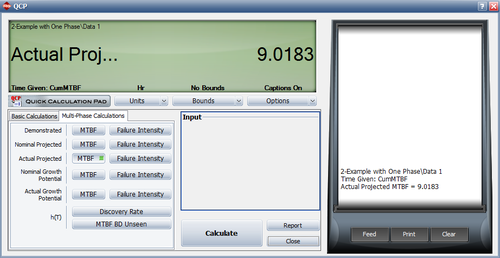Crow Extended - Continuous Evaluation Model Example: Difference between revisions
Chris Kahn (talk | contribs) No edit summary |
Lisa Hacker (talk | contribs) No edit summary |
||
| (3 intermediate revisions by 2 users not shown) | |||
| Line 1: | Line 1: | ||
<noinclude>{{Banner RGA Examples}} | <noinclude>{{Banner RGA Examples}} | ||
''This example appears in the [ | ''This example appears in the [https://help.reliasoft.com/reference/reliability_growth_and_repairable_system_analysis Reliability growth reference]''. | ||
</noinclude> | </noinclude> | ||
| Line 81: | Line 81: | ||
The following figure shows the data set entered in the RGA software's Multi-Phase data sheet. Note that because this is a time terminated test with a single phase ending at <math>T=400\,\!</math>, the last event entry is a phase (PH) with time to event = 400. | The following figure shows the data set entered in the RGA software's Multi-Phase data sheet. Note that because this is a time terminated test with a single phase ending at <math>T=400\,\!</math>, the last event entry is a phase (PH) with time to event = 400. | ||
[[Image:rga10.5.png|center| | [[Image:rga10.5.png|center|600px]] | ||
The next figure shows the effectiveness factors for the unfixed BD modes, and information concerning whether the fix will be implemented. Since we have only one test phase for this example, the notation "1" indicates that the fix will be implemented at the end of the first (and only) phase. | The next figure shows the effectiveness factors for the unfixed BD modes, and information concerning whether the fix will be implemented. Since we have only one test phase for this example, the notation "1" indicates that the fix will be implemented at the end of the first (and only) phase. | ||
[[Image:rga10.6.png|center| | [[Image:rga10.6.png|center|450px]] | ||
Do the following: | Do the following: | ||
#Determine the current demonstrated MTBF and failure intensity at time <math>T\,\!</math>. | |||
#Determine the nominal and actual average effectiveness factor at time <math>T\,\!</math>. | |||
#Determine the <math>p\,\!</math> ratio. | |||
#Determine the nominal and actual growth potential factor. | |||
#Determine the unfixed BD mode failure intensity at time <math>T.\,\!</math> | |||
#Determine the rate of discovery parameters and the rate of discovery function at time <math>T.\,\!</math> | |||
#Determine the nominal growth potential failure intensity and MTBF at time <math>T.\,\!</math> | |||
#Determine the nominal projected failure intensity and MTBF at time <math>T.\,\!</math> | |||
#Determine the actual growth potential failure intensity and MTBF at time <math>T.\,\!</math> | |||
#Determine the actual projected failure intensity and MTBF at time <math>T.\,\!</math> | |||
'''Solution''' | '''Solution''' | ||
<ol> | |||
<li>As described in the [[Crow-AMSAA (NHPP)|Crow-AMSAA (NHPP)]] chapter, for a time terminated test, <math>\beta \,\!</math> is estimated by the following equation: | |||
:<math>\widehat{\beta }=\frac{n}{n\ln {{T}^{*}}-\underset{i=1}{\overset{n}{\mathop{\sum }}}\,\ln {{T}_{i}}}\,\!</math> | |||
where <math>{{T}^{*}}\,\!</math> is the termination time and <math>n\,\!</math> is the total number of failures. In this example, <math>T^{*}=400\,\!</math> and <math>n=50\,\!</math>. Note that there are 5 fix implementation events and 1 event that marks the end of the phase. These should not be counted as failures. | |||
So in this case, we find that <math>\beta =0.9866.\,\!</math> | |||
We calculated the biased estimate of <math>\beta \,\!</math>, but note that we could have used the unbiased estimate as presented in the [[Crow-AMSAA (NHPP)#Biasing_and_Unbiasing_of_Beta|Crow-AMSAA (NHPP)]] chapter. The choice of calculating the biased or unbiased estimate of <math>\beta \,\!</math> can be configured in the Application Setup window in the RGA software. | |||
Solve for <math>\lambda ,\,\!</math> based on the Crow-AMSAA (NHPP) equation explained in the [[Crow-AMSAA (NHPP)#Parameter_Estimation_for_Failure_Times_Data|Crow_AMSAA (NHPP)]] chapter: | |||
:<math>\begin{align} | |||
\widehat{\lambda }= & \frac{n}{{{T}^{*\beta }}} \\ | \widehat{\lambda }= & \frac{n}{{{T}^{*\beta }}} \\ | ||
= & \frac{50}{{{400}^{0.9866}}} \\ | = & \frac{50}{{{400}^{0.9866}}} \\ | ||
| Line 125: | Line 121: | ||
\end{align}\,\!</math> | \end{align}\,\!</math> | ||
The demonstrated MTBF of the system at time <math>T=400\,\!</math> is: | |||
:<math>\begin{align} | |||
MTB{{F}_{D}}= & \frac{1}{\lambda \beta {{T}^{\beta -1}}} \\ | MTB{{F}_{D}}= & \frac{1}{\lambda \beta {{T}^{\beta -1}}} \\ | ||
= & 8.1087 | = & 8.1087 | ||
\end{align}\,\!</math> | \end{align}\,\!</math> | ||
The corresponding current demonstrated failure intensity is: | |||
:<math>\begin{align} | |||
{{\lambda }_{D}}= & \frac{1}{MTB{{F}_{D}}} \\ | {{\lambda }_{D}}= & \frac{1}{MTB{{F}_{D}}} \\ | ||
= & 0.1233 | = & 0.1233 | ||
\end{align}\,\!</math> | \end{align}\,\!</math> | ||
</li> | |||
<li>The average nominal effectiveness factor at time <math>T\,\!</math> is: | |||
:<math>\begin{align} | |||
{{d}_{N}}= & \frac{\underset{i=1}{\overset{M}{\mathop{\sum }}}\,{{d}_{Ni}}}{M} \\ | {{d}_{N}}= & \frac{\underset{i=1}{\overset{M}{\mathop{\sum }}}\,{{d}_{Ni}}}{M} \\ | ||
= & \frac{0.67+0.72+0.77+0.77+0.87+0.92+0.5+0.74+0.7+0.63+0.64+0.46}{12} \\ | = & \frac{0.67+0.72+0.77+0.77+0.87+0.92+0.5+0.74+0.7+0.63+0.64+0.46}{12} \\ | ||
| Line 150: | Line 144: | ||
\end{align}\,\!</math> | \end{align}\,\!</math> | ||
The average actual effectiveness factor at time <math>T\,\!</math> is given by: | |||
:<math>\begin{align} | |||
{{d}_{A}}= & \frac{\underset{i=1}{\overset{M}{\mathop{\sum }}}\,{{d}_{Ai}}}{M} \\ | {{d}_{A}}= & \frac{\underset{i=1}{\overset{M}{\mathop{\sum }}}\,{{d}_{Ai}}}{M} \\ | ||
= & \frac{0.67+0+0.77+0+0.87+0+0+0.74+0+0+0.64+0}{12} \\ | = & \frac{0.67+0+0.77+0+0.87+0+0+0.74+0+0+0.64+0}{12} \\ | ||
= & 0.3075 | = & 0.3075 | ||
\end{align}\,\!</math> | \end{align}\,\!</math> | ||
</li> | |||
<li>The <math>p\,\!</math> ratio is calculated by: | |||
:<math>\begin{align} | |||
p= & \frac{\text{Total number of distinct unfixed BD modes at time }400}{\text{Total number of distinct BD modes at time }400\text{ (both fixed and unfixed)}} \\ | p= & \frac{\text{Total number of distinct unfixed BD modes at time }400}{\text{Total number of distinct BD modes at time }400\text{ (both fixed and unfixed)}} \\ | ||
= & \frac{12}{12+5} \\ | = & \frac{12}{12+5} \\ | ||
= & 0.7059 | = & 0.7059 | ||
\end{align}\,\!</math> | \end{align}\,\!</math> | ||
</li> | |||
<li>The nominal growth potential factor is: | |||
:<math>{{\lambda }_{NGPFactor}}=\underset{i=1}{\overset{M}{\mathop \sum }}\,\left( 1-{{d}_{Ni}} \right)\frac{{{N}_{i}}}{T}\,\!</math> | |||
The total number <math>M\,\!</math> of distinct unfixed BD modes at time 400 is <math>M=12.\,\!</math> | |||
:<math>{{d}_{Ni}}\,\!</math> is the assigned (nominal) EF for the <math>{{i}^{th}}\,\!</math> unfixed BD mode at time <math>{{T}_{j}},\,\!</math> (which is shown in the picture of the Effectiveness Factors window given above). | :<math>{{d}_{Ni}}\,\!</math> is the assigned (nominal) EF for the <math>{{i}^{th}}\,\!</math> unfixed BD mode at time <math>{{T}_{j}},\,\!</math> (which is shown in the picture of the Effectiveness Factors window given above). | ||
:<math>{{N}_{i}}\,\!</math> is the total number of failures over (0, 400) for the distinct unfixed BD mode <math>i\,\!</math>. This is summarized in the following table. | :<math>{{N}_{i}}\,\!</math> is the total number of failures over (0, 400) for the distinct unfixed BD mode <math>i\,\!</math>. This is summarized in the following table. | ||
{|border="1" align="center" style="border-collapse: collapse;" cellpadding="5" cellspacing="5" | {|border="1" align="center" style="border-collapse: collapse;" cellpadding="5" cellspacing="5" | ||
| Line 216: | Line 205: | ||
|} | |} | ||
Based on the information given above, the nominal growth potential factor is calculated as: | |||
:<math>\begin{align} | |||
{{\lambda }_{NGPFactor}}=0.0153 | {{\lambda }_{NGPFactor}}=0.0153 | ||
\end{align}\,\!</math> | \end{align}\,\!</math> | ||
The actual growth potential factor is: | |||
:<math>{{\lambda }_{AGPFactor}}=\underset{i=1}{\overset{M}{\mathop \sum }}\,\left( 1-{{d}_{Ai}} \right)\frac{{{N}_{i}}}{T}\,\!</math> | |||
where <math>{{d}_{Ai}}\,\!</math> is the actual EF for the <math>{{i}^{th}}\,\!</math> unfixed BD mode at time 400, depending on whether a fix was implemented at time 400 or not. The next figure shows an event report from the RGA software where the actual EF is zero if a fix was not implemented at 400, or equal to the nominal EF if the fix was implemented at 400. | |||
[[Image:rga10.7.png|center|500px]] | |||
Based on the information given above, the actual growth potential factor is calculated as: | |||
:<math>\begin{align} | |||
{{\lambda }_{AGPFactor}}=0.0344 | {{\lambda }_{AGPFactor}}=0.0344 | ||
\end{align}\,\!</math> | \end{align}\,\!</math> | ||
</li> | |||
<li>The total number of unfixed BD modes listed in the data table is 21. The unfixed BD mode failure intensity at time 400 is: | |||
:<math>\begin{align} | |||
{{\lambda}_{BD unfixed}}= & \frac{\text{Total number of unfixed BD failure at time 400}}{400}\\ | {{\lambda}_{BD unfixed}}= & \frac{\text{Total number of unfixed BD failure at time 400}}{400}\\ | ||
= & \frac{21}{400}\\ | = & \frac{21}{400}\\ | ||
= & 0.0525 | = & 0.0525 | ||
\end{align}\,\!</math> | \end{align}\,\!</math> | ||
</li> | |||
<li>The discovery rate parameters at time 400 are calculated by using all the first occurrences of all the BD modes, both fixed and unfixed. <math>{{\hat{\beta }}_{BD}}\,\!</math> is the unbiased estimated of <math>\beta \,\!</math> for the Crow-AMSAA (NHPP) model based on the first occurrence of the 17 distinct BD modes in our example. <math>{{\hat{\lambda }}_{BD}}\,\!</math> is the unbiased estimate of <math>\lambda \,\!</math> for the Crow-AMSAA (NHPP) model based on the first occurrence of the 17 distinct BD modes. The next figure shows the first time to failure for each of the 17 distinct modes and the results of the analysis using the Crow-AMSAA (NHPP) model in the RGA software (note that in this case, the calculation settings in the User Setup is configured to calculate the unbiased <math>\beta \,\!</math>). | |||
[[Image:rga10.8.png|center|600px]] | |||
So we have: | |||
: | :<math>{{\widehat{\beta }}_{BD}}=0.6055\,\!</math> | ||
: | and: | ||
:<math>{{\widehat{\lambda }}_{BD}}=0.4518\,\!</math> | |||
The equations used to determine these parameters have been explained in question 1 of this example and are also presented in detail in the [[Crow-AMSAA (NHPP)#Parameter_Estimation|Crow-AMSA (NHPP)]] chapter. | |||
The discovery rate function at time 400 is: | |||
:<math>\begin{align} | |||
\widehat{h}(T|BD)= & {{\widehat{\lambda }}_{BD}}{{\widehat{\beta }}_{BD}}{{T}^{{{\widehat{\beta }}_{BD}}-1}} \\ | \widehat{h}(T|BD)= & {{\widehat{\lambda }}_{BD}}{{\widehat{\beta }}_{BD}}{{T}^{{{\widehat{\beta }}_{BD}}-1}} \\ | ||
= & 0.4518\cdot 0.6055\cdot {{400}^{0.6055-1}} \\ | = & 0.4518\cdot 0.6055\cdot {{400}^{0.6055-1}} \\ | ||
| Line 274: | Line 255: | ||
\end{align}\,\!</math> | \end{align}\,\!</math> | ||
This is the failure intensity of the unseen BD modes at time 400. In this case, it means that 0.0257 new BD modes are discovered per hour, or one new BD mode is discovered every 38.9 hours. | |||
</li> | |||
<li>The nominal growth potential failure intensity is: | |||
:<math>\begin{align} | |||
{{\lambda}_{NGP}}= & {{\lambda}_{D}} - {{\lambda }_{BD unfixed}} + {{\lambda }_{NGP Factor}} + {{d}_{N}} \cdot p \cdot h (400) - {{d}_{N}}h (400) \\ | {{\lambda}_{NGP}}= & {{\lambda}_{D}} - {{\lambda }_{BD unfixed}} + {{\lambda }_{NGP Factor}} + {{d}_{N}} \cdot p \cdot h (400) - {{d}_{N}}h (400) \\ | ||
= & 0.1233 - 0.0525 + 0.0153 + 0.6992 \cdot 0.7059 \cdot 0.0257 - 0.6992 \cdot 0.0257\\ | = & 0.1233 - 0.0525 + 0.0153 + 0.6992 \cdot 0.7059 \cdot 0.0257 - 0.6992 \cdot 0.0257\\ | ||
| Line 285: | Line 265: | ||
\end{align}\,\!</math> | \end{align}\,\!</math> | ||
This is the minimum attainable failure intensity if all delayed corrective actions are implemented for the modes that have been seen and delayed corrective actions are also implemented for the unseen BD modes, assuming testing would continue until all unseen BD modes are revealed. | |||
The nominal growth potential MTBF is: | |||
:<math>\begin{align} | |||
MTB{{F}_{NGP}}= & \frac{1}{{{\lambda }_{NGP}}} \\ | MTB{{F}_{NGP}}= & \frac{1}{{{\lambda }_{NGP}}} \\ | ||
= & \frac{1}{0.080} \\ | = & \frac{1}{0.080} \\ | ||
| Line 296: | Line 275: | ||
\end{align}\,\!</math> | \end{align}\,\!</math> | ||
This is the maximum attainable MTBF if all delayed corrective actions are implemented for the modes that have been seen and delayed corrective actions are also implemented for the unseen BD modes, assuming testing would continue until all unseen BD modes are revealed. | |||
</li> | |||
<li>The nominal projected failure intensity at time <math>400\,\!</math> is: | |||
:<math>\begin{align} | |||
{{\lambda }_{NP}}= & {{\lambda }_{NGP}}+{{d}_{N}}h(400) \\ | {{\lambda }_{NP}}= & {{\lambda }_{NGP}}+{{d}_{N}}h(400) \\ | ||
= & 0.080+0.6992\cdot 0.0257 \\ | = & 0.080+0.6992\cdot 0.0257 \\ | ||
| Line 307: | Line 285: | ||
\end{align}\,\!</math> | \end{align}\,\!</math> | ||
This is the projected failure intensity assuming all delayed fixes have been implemented for the modes that have been seen. | |||
: | The nominal projected MTBF at time 400 is: | ||
:<math>\begin{align} | |||
MTB{{F}_{NP}}= & \frac{1}{{{\lambda }_{NP}}} \\ | MTB{{F}_{NP}}= & \frac{1}{{{\lambda }_{NP}}} \\ | ||
= & \frac{1}{0.0988} \\ | = & \frac{1}{0.0988} \\ | ||
| Line 318: | Line 295: | ||
\end{align}\,\!</math> | \end{align}\,\!</math> | ||
This is the projected MTBF assuming all delayed fixes have been implemented for the modes that have been seen. | |||
</li> | |||
<li>The actual growth potential failure intensity is: | |||
:<math>\begin{align} | |||
{{\lambda}_{AGP}}= & {{\lambda}_{D}} - {{\lambda }_{BD unfixed}} + {{\lambda }_{AGP Factor}} + {{d}_{A}} \cdot p \cdot h (400) - {{d}_{A}}h (400) \\ | {{\lambda}_{AGP}}= & {{\lambda}_{D}} - {{\lambda }_{BD unfixed}} + {{\lambda }_{AGP Factor}} + {{d}_{A}} \cdot p \cdot h (400) - {{d}_{A}}h (400) \\ | ||
= & 0.1233 - 0.0525 + 0.0344 + 0.3075 \cdot 0.7059 \cdot 0.0257 - 0.3075 \cdot 0.0257\\ | = & 0.1233 - 0.0525 + 0.0344 + 0.3075 \cdot 0.7059 \cdot 0.0257 - 0.3075 \cdot 0.0257\\ | ||
| Line 329: | Line 305: | ||
\end{align}\,\!</math> | \end{align}\,\!</math> | ||
This is the minimum attainable failure intensity based on the current management strategy. | |||
: | The actual growth potential MTBF is: | ||
:<math>\begin{align} | |||
MTB{{F}_{AGP}}= & \frac{1}{{{\lambda }_{AGP}}} \\ | MTB{{F}_{AGP}}= & \frac{1}{{{\lambda }_{AGP}}} \\ | ||
= & \frac{1}{0.1029} \\ | = & \frac{1}{0.1029} \\ | ||
| Line 340: | Line 315: | ||
\end{align}\,\!</math> | \end{align}\,\!</math> | ||
This is the maximum attainable MTBF based on the current management strategy. | |||
</li> | |||
<li>The actual projected failure intensity at time 400 is: | |||
:<math>\begin{align} | |||
{{\lambda }_{AP}}= & {{\lambda }_{AGP}}+{{d}_{A}}\cdot h\left( 400 \right) \\ | {{\lambda }_{AP}}= & {{\lambda }_{AGP}}+{{d}_{A}}\cdot h\left( 400 \right) \\ | ||
= & 0.1029+0.3075\cdot 0.0257 \\ | = & 0.1029+0.3075\cdot 0.0257 \\ | ||
| Line 351: | Line 325: | ||
\end{align}\,\!</math> | \end{align}\,\!</math> | ||
This is the projected failure intensity based on the current management strategy. | |||
The actual projected MTBF at time 400 is: | |||
:<math>\begin{align} | |||
MTB{{F}_{AP}}= & \frac{1}{{{\lambda }_{AP}}} \\ | MTB{{F}_{AP}}= & \frac{1}{{{\lambda }_{AP}}} \\ | ||
= & \frac{1}{0.1108} \\ | = & \frac{1}{0.1108} \\ | ||
| Line 362: | Line 335: | ||
\end{align}\,\!</math> | \end{align}\,\!</math> | ||
This is the projected MTBF based on the current management strategy. | |||
The next figure demonstrates how we can derive the results of this example by using the software's Quick Calculation Pad (QCP). Here we chose to calculate the actual projected MTBF. | |||
[[Image:rga10.9.png|center| | [[Image:rga10.9.png|center|500px]]</li> | ||
</ol> | |||
Latest revision as of 21:31, 18 September 2023
New format available! This reference is now available in a new format that offers faster page load, improved display for calculations and images and more targeted search.
As of January 2024, this Reliawiki page will not continue to be updated. Please update all links and bookmarks to the latest references at RGA examples and RGA reference examples.
This example appears in the Reliability growth reference.
The following table shows a date set with failure and fix implementation events.
| Multi-Phase Data for a Time Terminated Test at [math]\displaystyle{ T=400\,\! }[/math] | ||||||||
| Event | Time to Event | Classification | Mode | Event | Time to Event | Classification | Mode | |
|---|---|---|---|---|---|---|---|---|
| F | 0.7 | BD | 1000 | F | 244.8 | A | 3 | |
| F | 15 | BD | 2000 | F | 249 | BD | 13000 | |
| F | 17.6 | BC | 200 | F | 250.8 | A | 2 | |
| F | 25.3 | BD | 3000 | F | 260.1 | BD | 2000 | |
| F | 47.5 | BD | 4000 | F | 273.1 | A | 5 | |
| I | 50 | BD | 1000 | F | 274.7 | BD | 11000 | |
| F | 54 | BD | 5000 | I | 280 | BD | 9000 | |
| F | 54.5 | BC | 300 | F | 282.8 | BC | 902 | |
| F | 56.4 | BD | 6000 | F | 285 | BD | 14000 | |
| F | 63.6 | A | 1 | F | 315.4 | BD | 4000 | |
| F | 72.2 | BD | 5000 | F | 317.1 | A | 3 | |
| F | 99.2 | BC | 400 | F | 320.6 | A | 1 | |
| F | 99.6 | BD | 7000 | F | 324.5 | BD | 12000 | |
| F | 100.3 | BD | 8000 | F | 324.9 | BD | 10000 | |
| F | 102.5 | A | 2 | F | 342 | BD | 5000 | |
| F | 112 | BD | 9000 | F | 350.2 | BD | 3000 | |
| F | 112.2 | BC | 500 | F | 355.2 | BC | 903 | |
| F | 120.9 | BD | 2000 | F | 364.6 | BD | 10000 | |
| F | 121.9 | BC | 600 | F | 364.9 | A | 1 | |
| F | 125.5 | BD | 10000 | I | 365 | BD | 10000 | |
| F | 133.4 | BD | 11000 | F | 366.3 | BD | 2000 | |
| F | 151 | BC | 700 | F | 379.4 | BD | 15000 | |
| F | 163 | BC | 800 | F | 389 | BD | 16000 | |
| F | 174.5 | BC | 900 | I | 390 | BD | 15000 | |
| F | 177.4 | BD | 10000 | I | 393 | BD | 16000 | |
| F | 191.6 | BC | 901 | F | 394.9 | A | 3 | |
| F | 192.7 | BD | 12000 | F | 395.2 | BD | 17000 | |
| F | 213 | A | 1 | |||||
The following figure shows the data set entered in the RGA software's Multi-Phase data sheet. Note that because this is a time terminated test with a single phase ending at [math]\displaystyle{ T=400\,\! }[/math], the last event entry is a phase (PH) with time to event = 400.
The next figure shows the effectiveness factors for the unfixed BD modes, and information concerning whether the fix will be implemented. Since we have only one test phase for this example, the notation "1" indicates that the fix will be implemented at the end of the first (and only) phase.
Do the following:
- Determine the current demonstrated MTBF and failure intensity at time [math]\displaystyle{ T\,\! }[/math].
- Determine the nominal and actual average effectiveness factor at time [math]\displaystyle{ T\,\! }[/math].
- Determine the [math]\displaystyle{ p\,\! }[/math] ratio.
- Determine the nominal and actual growth potential factor.
- Determine the unfixed BD mode failure intensity at time [math]\displaystyle{ T.\,\! }[/math]
- Determine the rate of discovery parameters and the rate of discovery function at time [math]\displaystyle{ T.\,\! }[/math]
- Determine the nominal growth potential failure intensity and MTBF at time [math]\displaystyle{ T.\,\! }[/math]
- Determine the nominal projected failure intensity and MTBF at time [math]\displaystyle{ T.\,\! }[/math]
- Determine the actual growth potential failure intensity and MTBF at time [math]\displaystyle{ T.\,\! }[/math]
- Determine the actual projected failure intensity and MTBF at time [math]\displaystyle{ T.\,\! }[/math]
Solution
- As described in the Crow-AMSAA (NHPP) chapter, for a time terminated test, [math]\displaystyle{ \beta \,\! }[/math] is estimated by the following equation:
- [math]\displaystyle{ \widehat{\beta }=\frac{n}{n\ln {{T}^{*}}-\underset{i=1}{\overset{n}{\mathop{\sum }}}\,\ln {{T}_{i}}}\,\! }[/math]
- [math]\displaystyle{ \begin{align} \widehat{\lambda }= & \frac{n}{{{T}^{*\beta }}} \\ = & \frac{50}{{{400}^{0.9866}}} \\ = & 0.1354 \end{align}\,\! }[/math]
- [math]\displaystyle{ \begin{align} MTB{{F}_{D}}= & \frac{1}{\lambda \beta {{T}^{\beta -1}}} \\ = & 8.1087 \end{align}\,\! }[/math]
- [math]\displaystyle{ \begin{align} {{\lambda }_{D}}= & \frac{1}{MTB{{F}_{D}}} \\ = & 0.1233 \end{align}\,\! }[/math]
- The average nominal effectiveness factor at time [math]\displaystyle{ T\,\! }[/math] is:
- [math]\displaystyle{ \begin{align} {{d}_{N}}= & \frac{\underset{i=1}{\overset{M}{\mathop{\sum }}}\,{{d}_{Ni}}}{M} \\ = & \frac{0.67+0.72+0.77+0.77+0.87+0.92+0.5+0.74+0.7+0.63+0.64+0.46}{12} \\ = & 0.6992 \end{align}\,\! }[/math]
- [math]\displaystyle{ \begin{align} {{d}_{A}}= & \frac{\underset{i=1}{\overset{M}{\mathop{\sum }}}\,{{d}_{Ai}}}{M} \\ = & \frac{0.67+0+0.77+0+0.87+0+0+0.74+0+0+0.64+0}{12} \\ = & 0.3075 \end{align}\,\! }[/math]
- The [math]\displaystyle{ p\,\! }[/math] ratio is calculated by:
- [math]\displaystyle{ \begin{align} p= & \frac{\text{Total number of distinct unfixed BD modes at time }400}{\text{Total number of distinct BD modes at time }400\text{ (both fixed and unfixed)}} \\ = & \frac{12}{12+5} \\ = & 0.7059 \end{align}\,\! }[/math]
- The nominal growth potential factor is:
- [math]\displaystyle{ {{\lambda }_{NGPFactor}}=\underset{i=1}{\overset{M}{\mathop \sum }}\,\left( 1-{{d}_{Ni}} \right)\frac{{{N}_{i}}}{T}\,\! }[/math]
- [math]\displaystyle{ {{d}_{Ni}}\,\! }[/math] is the assigned (nominal) EF for the [math]\displaystyle{ {{i}^{th}}\,\! }[/math] unfixed BD mode at time [math]\displaystyle{ {{T}_{j}},\,\! }[/math] (which is shown in the picture of the Effectiveness Factors window given above).
- [math]\displaystyle{ {{N}_{i}}\,\! }[/math] is the total number of failures over (0, 400) for the distinct unfixed BD mode [math]\displaystyle{ i\,\! }[/math]. This is summarized in the following table.
Number of Failures for Unfixed BD Modes Classification Mode Number of Failures BD 2000 4 BD 3000 2 BD 4000 2 BD 5000 3 BD 6000 1 BD 7000 1 BD 8000 1 BD 11000 2 BD 12000 2 BD 13000 1 BD 14000 1 BD 17000 1 Sum = 21 Based on the information given above, the nominal growth potential factor is calculated as:
- [math]\displaystyle{ \begin{align} {{\lambda }_{NGPFactor}}=0.0153 \end{align}\,\! }[/math]
The actual growth potential factor is:
- [math]\displaystyle{ {{\lambda }_{AGPFactor}}=\underset{i=1}{\overset{M}{\mathop \sum }}\,\left( 1-{{d}_{Ai}} \right)\frac{{{N}_{i}}}{T}\,\! }[/math]
where [math]\displaystyle{ {{d}_{Ai}}\,\! }[/math] is the actual EF for the [math]\displaystyle{ {{i}^{th}}\,\! }[/math] unfixed BD mode at time 400, depending on whether a fix was implemented at time 400 or not. The next figure shows an event report from the RGA software where the actual EF is zero if a fix was not implemented at 400, or equal to the nominal EF if the fix was implemented at 400.
Based on the information given above, the actual growth potential factor is calculated as:
- [math]\displaystyle{ \begin{align} {{\lambda }_{AGPFactor}}=0.0344 \end{align}\,\! }[/math]
- The total number of unfixed BD modes listed in the data table is 21. The unfixed BD mode failure intensity at time 400 is:
- [math]\displaystyle{ \begin{align} {{\lambda}_{BD unfixed}}= & \frac{\text{Total number of unfixed BD failure at time 400}}{400}\\ = & \frac{21}{400}\\ = & 0.0525 \end{align}\,\! }[/math]
- The discovery rate parameters at time 400 are calculated by using all the first occurrences of all the BD modes, both fixed and unfixed. [math]\displaystyle{ {{\hat{\beta }}_{BD}}\,\! }[/math] is the unbiased estimated of [math]\displaystyle{ \beta \,\! }[/math] for the Crow-AMSAA (NHPP) model based on the first occurrence of the 17 distinct BD modes in our example. [math]\displaystyle{ {{\hat{\lambda }}_{BD}}\,\! }[/math] is the unbiased estimate of [math]\displaystyle{ \lambda \,\! }[/math] for the Crow-AMSAA (NHPP) model based on the first occurrence of the 17 distinct BD modes. The next figure shows the first time to failure for each of the 17 distinct modes and the results of the analysis using the Crow-AMSAA (NHPP) model in the RGA software (note that in this case, the calculation settings in the User Setup is configured to calculate the unbiased [math]\displaystyle{ \beta \,\! }[/math]).
So we have:
- [math]\displaystyle{ {{\widehat{\beta }}_{BD}}=0.6055\,\! }[/math]
and:
- [math]\displaystyle{ {{\widehat{\lambda }}_{BD}}=0.4518\,\! }[/math]
The equations used to determine these parameters have been explained in question 1 of this example and are also presented in detail in the Crow-AMSA (NHPP) chapter.
The discovery rate function at time 400 is:
- [math]\displaystyle{ \begin{align} \widehat{h}(T|BD)= & {{\widehat{\lambda }}_{BD}}{{\widehat{\beta }}_{BD}}{{T}^{{{\widehat{\beta }}_{BD}}-1}} \\ = & 0.4518\cdot 0.6055\cdot {{400}^{0.6055-1}} \\ = & 0.0257 \end{align}\,\! }[/math]
This is the failure intensity of the unseen BD modes at time 400. In this case, it means that 0.0257 new BD modes are discovered per hour, or one new BD mode is discovered every 38.9 hours.
- The nominal growth potential failure intensity is:
- [math]\displaystyle{ \begin{align} {{\lambda}_{NGP}}= & {{\lambda}_{D}} - {{\lambda }_{BD unfixed}} + {{\lambda }_{NGP Factor}} + {{d}_{N}} \cdot p \cdot h (400) - {{d}_{N}}h (400) \\ = & 0.1233 - 0.0525 + 0.0153 + 0.6992 \cdot 0.7059 \cdot 0.0257 - 0.6992 \cdot 0.0257\\ = & 0.080 \end{align}\,\! }[/math]
- [math]\displaystyle{ \begin{align} MTB{{F}_{NGP}}= & \frac{1}{{{\lambda }_{NGP}}} \\ = & \frac{1}{0.080} \\ = & 12.37 \end{align}\,\! }[/math]
- The nominal projected failure intensity at time [math]\displaystyle{ 400\,\! }[/math] is:
- [math]\displaystyle{ \begin{align} {{\lambda }_{NP}}= & {{\lambda }_{NGP}}+{{d}_{N}}h(400) \\ = & 0.080+0.6992\cdot 0.0257 \\ = & 0.0988 \end{align}\,\! }[/math]
- [math]\displaystyle{ \begin{align} MTB{{F}_{NP}}= & \frac{1}{{{\lambda }_{NP}}} \\ = & \frac{1}{0.0988} \\ = & 10.11 \end{align}\,\! }[/math]
- The actual growth potential failure intensity is:
- [math]\displaystyle{ \begin{align} {{\lambda}_{AGP}}= & {{\lambda}_{D}} - {{\lambda }_{BD unfixed}} + {{\lambda }_{AGP Factor}} + {{d}_{A}} \cdot p \cdot h (400) - {{d}_{A}}h (400) \\ = & 0.1233 - 0.0525 + 0.0344 + 0.3075 \cdot 0.7059 \cdot 0.0257 - 0.3075 \cdot 0.0257\\ = & 0.1029 \end{align}\,\! }[/math]
- [math]\displaystyle{ \begin{align} MTB{{F}_{AGP}}= & \frac{1}{{{\lambda }_{AGP}}} \\ = & \frac{1}{0.1029} \\ = & 9.71 \end{align}\,\! }[/math]
- The actual projected failure intensity at time 400 is:
- [math]\displaystyle{ \begin{align} {{\lambda }_{AP}}= & {{\lambda }_{AGP}}+{{d}_{A}}\cdot h\left( 400 \right) \\ = & 0.1029+0.3075\cdot 0.0257 \\ = & 0.1108 \end{align}\,\! }[/math]
- [math]\displaystyle{ \begin{align} MTB{{F}_{AP}}= & \frac{1}{{{\lambda }_{AP}}} \\ = & \frac{1}{0.1108} \\ = & 9.01 \end{align}\,\! }[/math]

